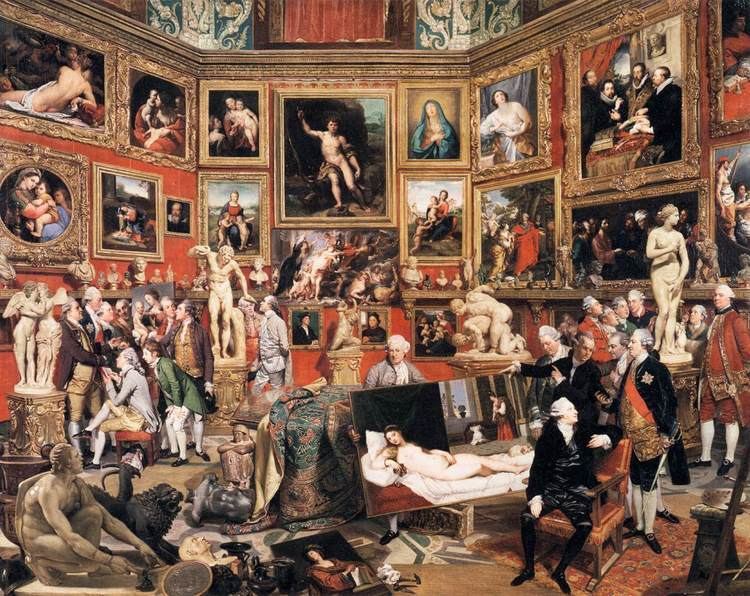Year 1772–78 Artist Johann Zoffany | Medium Oil painting Created 1772 | |
 | ||
Dimensions 123.5 cm × 155.0 cm (48.6 in × 61.0 in) Location Royal Collection, Windsor Castle Similar Venus de' Medici, Colonel Mordaunt's Cock Mat, Arrotino, Wrestlers, The Death of Captain James C | ||
The Tribuna of the Uffizi (1772–1778) by Johan Zoffany is a painting of the north-east section of the Tribuna room in the Uffizi in Florence, Italy. The painting is part of the United Kingdom's Royal Collection.
Contents
Production
In the summer of 1772 Zoffany left London for Florence with a commission from Queen Charlotte to paint 'the Florence Gallery'. (Neither she nor her husband George III ever visited Italy in person.) Felton Hervey, who had a large art collection and who knew the Royal family, met Zoffany in Florence. He was included in a prominent position in the painting by December 1772. Zoffany was still working on the painting late in 1777; he only finally returned to England in 1779. By this time Hervey had died.
History
Johan Zoffany was a German born painter who had become successful in London. One of his principal patrons was the Royal family. Queen Charlotte had sent Zoffany to Florence where he had agreed to paint the Tribuna of the Uffizi. The agreed price was high and he was paid £300.
Artworks shown
Zoffany has varied the arrangement of the artworks and introduced others from elsewhere in the Medici collection. He gained special privileges, with the help of George, 3rd Earl Cowper (1738–80), and Sir Horace Mann, 1st Baronet (1706–86), such as having seven paintings, including Raphael's Madonna della Sedia, temporarily brought in from the Pitti Palace so that he could paint them in situ in the Tribuna. In thanks Zoffany included a portrait of Cowper looking at his recent acquisition, Raphael's Niccolini-Cowper Madonna (Cowper hoped to sell it on to George III; it is now in the Washington National Gallery of Art), with Zoffany holding it (to the left of the Dancing Faun).
The unframed Samian Sibyl on the floor was acquired for the Medici collection in 1777. It was a workshop copy of the pendant to Guercino's Libyan Sibyl, recently bought by George III, and may be intended as a compliment to him.
Sculptures and other
Today Medici's Ancient Roman statues are mostly in the main corridors of the Uffizi Gallery, except those which are still in the Tribuna, and except the smaller busts and statuettes (some antique, some pseudo-antique), owned by the National Archaeological Museum and permanently displayed at Villa Corsini a Castello, near Florence. Many of those painted by Zoffany are still to be identified, thou. Other antiquities (Etruscan, Egyptian, Greek) are mostly in the National Archaeological Museum. Some very few Renaissance pieces from the Tribuna are now in the Bargello Museum.
Persons shown
All the connoisseurs, diplomats and visitors to Florence portrayed are identifiable, making the painting a combination of the British 18th-century conversation piece or informal group portrait genre, with that of the predominantly Flemish 17th-century tradition of gallery views and wunderkammers. However, this inclusion of so many recognisable portraits led to criticism at the time by Zoffany's royal patrons, and by Horace Walpole, who called it "a flock of travelling boys, and one does not know nor care whom."
Pietro Bastianelli, curator of the Uffizi Gallery, shows the Venus of Urbino di Titian to Mr. Gordon, Thomas Patch (probably the man touching the Venus) and Felton Hervey, who is looking back towards Sir John Taylor and Sir Horace Mann.
